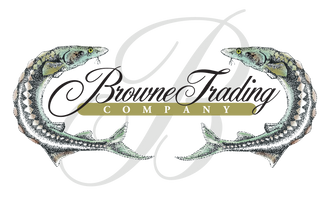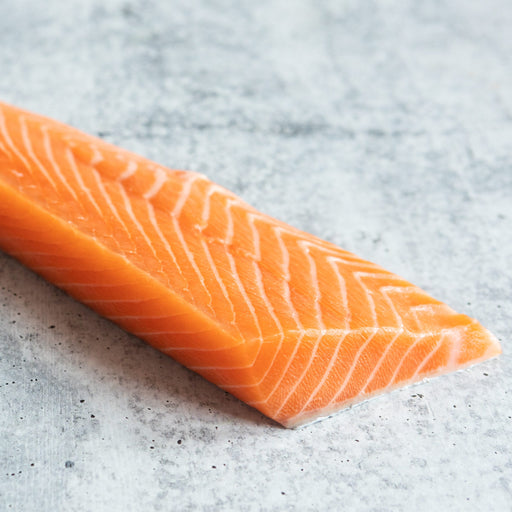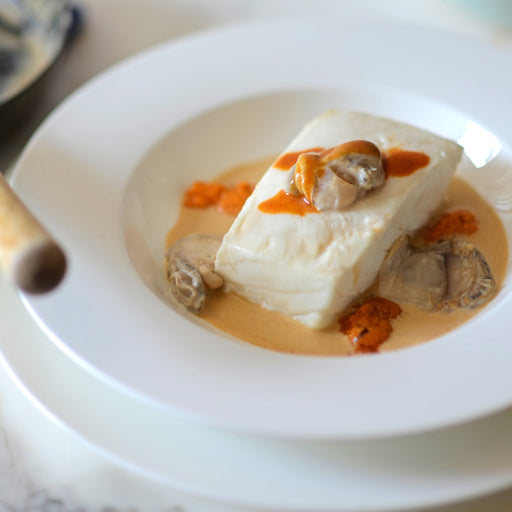
Ocean to Plate: The Journey of Quality Seafood
We have many wild caught seafood options here at Browne. This article will help explain how the fresh wild caught/harvested seafood we offer at Browne goes from the boat to your kitchen. It has to be said that getting pristine quality seafood from the world’s oceans to the dinner plate is no simple task. When chefs & customers rely on fresh, never frozen, wild-caught fish to arrive, the proverbial clock starts the minute the fish is on the hook (or in the net) & brought onboard the fishing vessel.
There is more to this journey than refrigerated transportation; freshness & superior quality starts with the catch method, continues with the fishermen, & finishes with the fishmonger. A break anywhere in this chain can result in less than quality seafood. Since our inception in 1991, Browne Trading has been recognized for its top quality, pristine seafood. Our success has been based not just upon sourcing from best practice fisheries with consistency, but also upon our ability to select & handle our fish with the highest level of expertise prior to sale.
Catch Methods Can Impact Quality

Commercial fishing utilizes a multitude of different catch methods for wild fisheries. The type of gear used is chosen based on a multitude of factors – type of fish desired (& where it lives in the water column), the capacity of catch desired (ie. small day boats can hold only so many fish, versus industrial “factory” vessels), & the fishing area (deep ocean versus inshore fishery) – are some of the major considerations. While there are literally hundreds of catch methods known to man, the principle modern methods utilize either net (trawls, seines, & gillnets are the most common) or hooks (hand lines, trolls, jigs & long lines). Other methods such as dredging & pots/traps are methods primarily used for live shellfish capture. To learn more about catch methods, visit Monterey Bay Aquarium Seafood Watch which has some very useful graphic explanations.
All catch methods can have advantages & disadvantages alike. Some result in unwanted bycatches or cannot target fish of specific sizes, such as juveniles. Others can have an unwanted impact on ocean ecology. But from a strict quality standpoint, the methods that inflict the least amount of catch trauma &/or aid in the timeliness of fish-to-vessel-to-dock are the ones we generally consider superior – & hook-caught fish are always preferential. Longlining for example often lands the fish while still alive; whereas gillnets usually kill upon capture, resulting in fish that may begin deterioration even before they are brought Longlining for example often lands the fish while still alive; whereas gillnets usually kill upon capture, resulting in fish that may begin deterioration even before they are brought onboard. Trawls can also land live fish, but sometimes the large tonnage of the catch itself can inflict some damage to the fish when the nets are hauled onboard.
While catch methods often have a bearing upon the condition of the fish, they are all ultimately designed for the purpose of landing them, & seafood buyers know not to be prejudicial to the method type if the quality remains consistently sound.
Quality is Contingent Upon the Boats

Linda Greenlaw & our Founder, President & Owner Rod Browne Mitchell with a Bluefin Tuna on a Day Boat
While the gear employed to bring in the fish can play a significant role in their kitchen quality, how the fish is handled immediately upon catch on the boat is of even greater importance. Once caught, fish need to be transferred out of the gear, sorted & graded in a manner that does not damage or bruise the fish – & done so with sensitivity towards the time out of the water. Proper bleeding, gutting & washing on deck are critical as this initial processing will go a long way to preserving the fish.
Finally, & most essentially, how well & how quickly the fish is placed on ice & chilled prior to landing can ensure the difference between premium & ruined seafood. Proper chilling ensures preservation of texture & flavor & deters bacteria & deterioration. Fish left sitting in water for prolonged periods of time, or that are handled roughly & carelessly, are easy candidates for low market quality once they reach port. Finding the boats that consistently treat their catches with the highest level of care is always at the top of Browne’s priority. After decades in the industry, we have developed both reliable & consistent sources for our wild-caught fish.
Timing is Everything

Our Founder, President & Owner Rod Browne Mitchell here on a Day Boat with a Fresh Caught Halibut
Timing from catch to the dock is also a major factor. Dayboats (or Trip Boats) are vessels that fish & return in the shortest amount of time, generally a day or overnight trip. Because they catch & return so quickly, Browne gives preference to fish brought in on dayboats. However, some deep water catches require longer voyages to travel to the fishing grounds & set gear. In these instances, we seek out the “last day” catches from these boats, the last caught & freshest fish on the vessel, sometimes called the “top” of the catch, as fish will be on the top of the hold & the first unloaded. When buying fresh fish from overseas or out of state fisheries, how quickly they are expedited to the fishmonger is imperative to their quality. As an example, the majority of our wild caught European fish is brought dockside in Portugal & France by our committed agents who have been doing business with Browne for years. They only select fish that meet our high-quality criteria. These wild fish are fresh, never frozen, & shipped overnight to us in Maine well within 24 hours of being caught. The fish are local to the European North Atlantic & the Mediterranean & are line caught by day boat fishermen. Rapid transport & expert packing to preserve temperature assures that the quality is not compromised in transit. When done properly it is not uncommon for us to receive fish still in a state of rigor mortis, a welcomed condition indicative of the freshest possible catch!
Browne Sells Only the Best - and We Make Sure it Arrives That Way

Rod Browne Mitchell with a Fresh Halibut that has just arrived at Browne
There is a lot of seafood landed to market & not all of it is pristine. Much of it doesn’t have to be as it is destined to be processed & frozen (or refrozen). But for customers’ seeking the best in fresh, sushi-grade fish, reliance upon the fishmonger to select & deliver the best is the final stage of the fish’s journey from boat to plate. If the fishmonger cannot discern the quality – or handle & deliver it to sustain its freshness – then all the steps taken to procure quality fish are lost to the customer. Handling whole fish (which is the majority of what we purchase) is the ideal way to grade the quality since indicators of freshness – eyes, gills, scales, belly, odor, etc. – are intact upon receipt.
At Browne Trading, we grade our fish as “Pristine Quality” based on the following parameters:
- Fish is received at or below required temperature
- Eyes on the fish are still pigmented & clear
- Fish is in “rigor mortis” state with tight, firm flesh & red gills indicative of fresh catch
- The skin of the fish has zero scale loss, has vibrant & visible coloring, no skin blemishes such as gashes or tumors
- No odor – except the natural smell of the sea
- In the case of live shellfish, we make sure product is lively & kept at a proper temperature
Storage of Seafood at Browne

All the fish that is accepted for sale at Browne is stored in our coolers & kept chilled with salt-water ice for ‘ocean cold’ products. Typically, Browne Trading fish only stay on our premises for a maximum of 48 hours, although most items arrive in the morning, & are gone by nightfall. We continually inspect all of our seafood, & never ship any fish that does not meet Browne Trading Quality Standards. With all sources, we place a high premium on the traceability of the catch – from fishing ground, catch method, vessel, where it is landed, & how & when it is transported to our facility.
Knowing exactly what the species is – & not just market names, which can vary from country to country & even state to state – is also important so that the customer knows exactly what species they are eating. Finally, all our seafood is hand packed by our trained packing crew with cold packs & air balloons to make sure that our products arrive in pristine condition.
Whether it ships by a Browne Trading truck, one of our partner carriers, or via Overnight Shipment, our customers are assured that their fish & seafood is well cared for at every step. Regardless if you are buying from Browne Trading or your local fishmonger, fish stall or grocery store, you should know exactly what fish species you are buying, where & how it was caught, & where it came from. Quality speaks for itself, & learning how to evaluate your seafood will go a long way in getting the most value on your purchase.
Featured collection
Ora King Salmon
"The best salmon I’ve ever tasted. Succulent and rich, the cut of salmon transcended salmon." - Food & Wine Magazine on Ora King Salmon 1 skin...
View full detailsNorth Atlantic Salmon
1 skin-on fillet, 3-4 pounds, fresh2 skin-off portions, 1 pound total, frozen Premium quality, sushi-grade fish Sustainably aquacultured Browne be...
View full detailsNorth Atlantic Halibut
2 pound, skin-on fillet, fresh2 portions, skin-off, 1 pound total, frozen Sustainably caught according to local regulations and quotas Landed whol...
View full detailsFarmed Dover Sole
2 whole fish, 2 pounds total, skin-on & gutted4 skin-on fillets, 1 pound total, fresh or frozen Iconic for French cuisine Expertly raised by S...
View full detailsMaine Bluefin Toro
2 pounds, fresh Regulated by ICCAT and NMFS Each purchase supports local fishermen and the Maine economy #1 sushi-grade and never frozen for peak...
View full details










Leave a comment